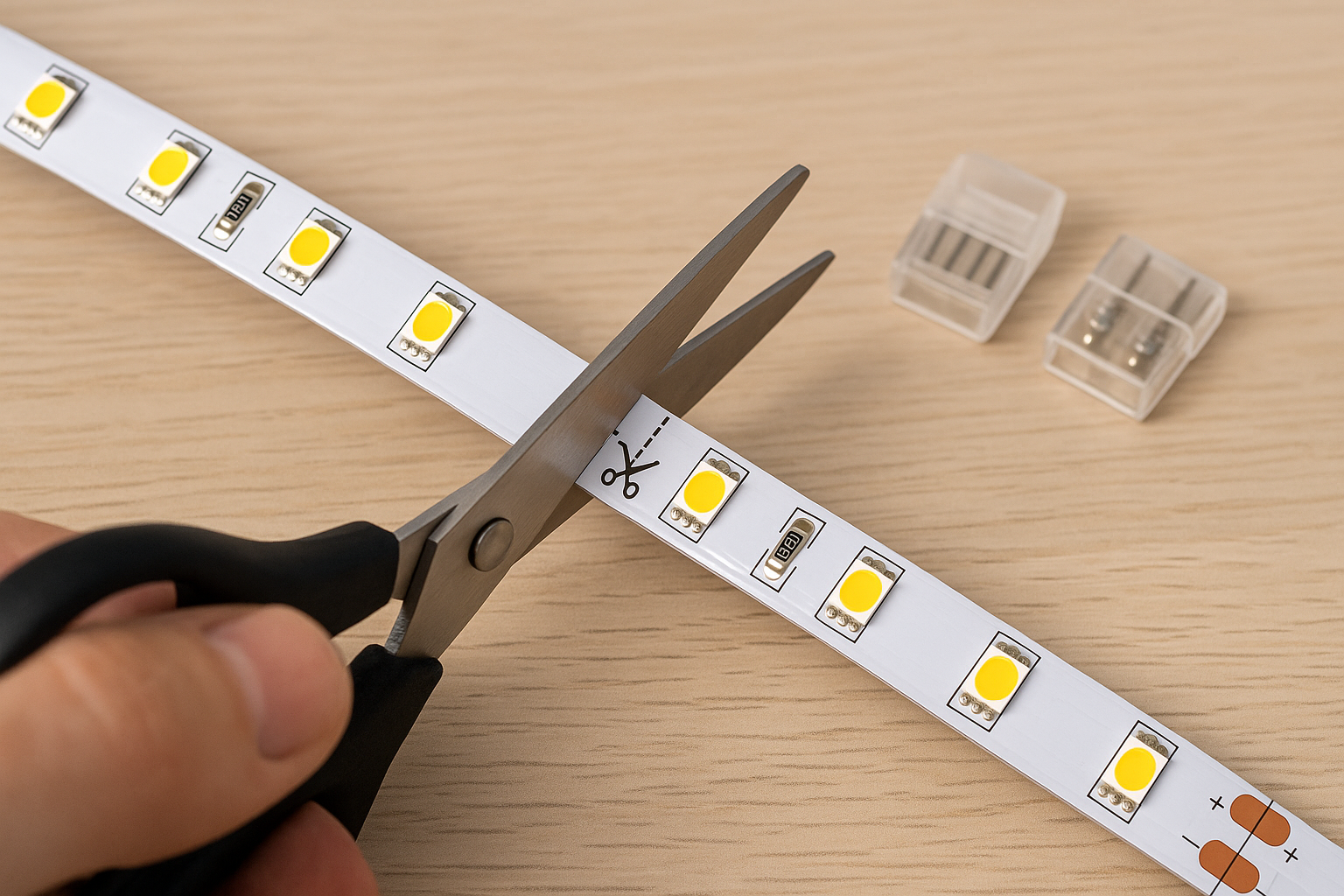- What Are LED Strip Lights?
- Can You Cut LED Strip Lights? (Answered)
- How to Safely Cut LED Strip Lights
- Where to Cut LED Strip Lights: Understanding Cut Lines
- Do All LED Strip Lights Allow Cutting?
- Tools Needed to Cut LED Strip Lights Properly
- How to Reconnect or Extend Cut LED Strip Lights
- Common Mistakes to Avoid When Cutting LED Strips
- Conclusion
LED strip lights have surged in popularity for everything from accent lighting in homes to custom setups in vehicles, workspaces, and events. They offer flexibility, vibrant illumination, and ease of installation. But a common question among DIYers and homeowners is: can you cut LED strip lights?
The short answer is yes—you can cut LED strip lights. However, it must be done correctly to maintain functionality and safety. In this guide, we’ll explore everything you need to know about cutting LED strip lights, including the tools you need, where to cut, and how to reconnect them.
What Are LED Strip Lights?
LED strip lights are flexible circuit boards populated with surface-mounted light-emitting diodes (SMD LEDs) that usually come with an adhesive backing. They're widely used for decorative lighting, under-cabinet illumination, task lighting, and even mood lighting for gaming setups or living rooms.
Most LED strip lights operate on low voltage (commonly 12V or 24V DC) and come in various lengths and color options, including RGB (Red, Green, Blue) and tunable white.
Can You Cut LED Strip Lights? (Answered)
Yes, you can cut LED strip lights without damaging the entire strip—but only at specific points. These designated cutting zones are marked along the strip and usually appear every few inches. Cutting outside these areas can render a section of the strip inoperable.
This ability to cut makes LED strips highly customizable for different applications. Whether you need a shorter length to fit behind a TV or want to split a long strip for multiple areas, proper cutting allows flexibility without waste.
How to Safely Cut LED Strip Lights
- Unplug the Power Source: Always disconnect the strip from any power supply before cutting.
- Locate the Cut Marks: Look for the scissor icon or a dashed line on the strip.
- Use Sharp Scissors or Precision Cutters: Make a clean cut right through the marked line.
- Avoid Bending While Cutting: Keep the strip flat to ensure an even cut.
A clean cut at the designated mark ensures that the copper contacts remain intact for reconnection or continued use.
Where to Cut LED Strip Lights: Understanding Cut Lines
Every LED strip features specific points where it can be safely cut. These are typically located between two sets of copper pads. The spacing depends on the strip’s design:
- 12V Strips: Cut points are usually every 3 LEDs (about 2 inches).
- 24V Strips: Cut points might occur every 6 LEDs (about 4 inches).
Cutting between these lines can damage the circuit and cause part of the strip to stop working. Always double-check the voltage and type of strip before cutting.
Do All LED Strip Lights Allow Cutting?
While most flexible LED strips are cuttable, not all are designed for modification. Here are a few things to consider:
- Smart LED Strips: Some Wi-Fi or app-controlled strips have integrated circuit chips. Cutting them might disrupt their functionality.
- High-Density Strips: These may have complex circuitry, making them harder to cut and reconnect.
- Waterproof LED Strips: Often encased in a silicone sleeve, these need to be resealed properly after cutting to maintain their IP rating.
Always check the manufacturer’s guidelines before making modifications.
Tools Needed to Cut LED Strip Lights Properly
- Sharp scissors or wire cutters
- LED strip connectors (optional)
- Soldering kit (for permanent connections)
- Heat shrink tubing (for waterproofing)
- Ruler or measuring tape (for accuracy)
Using the right tools ensures a safer and more efficient process, particularly if you plan to reconnect or extend the strip later.
How to Reconnect or Extend Cut LED Strip Lights
1. Using Connectors
Clip-on connectors are a solder-free way to join two strips. Simply align the copper pads with the connector and clamp it shut. Ensure you match the polarity correctly.
2. Soldering Wires
For a more durable solution, solder wires between the cut segments. This is ideal for permanent installations and allows for flexible routing around corners or obstacles.
Waterproof Reconnection
If you're working with waterproof strips, apply silicone glue and heat shrink tubing to reseal the cut ends after reconnection.
Common Mistakes to Avoid When Cutting LED Strips
- Cutting at the Wrong Spot: This is the most common error. Always use the marked lines.
- Forgetting to Power Down: Cutting live wires can cause electric shock or short-circuit the strip.
- Using the Wrong Connectors: Mismatched connectors can result in poor or no connectivity.
- Failing to Seal Waterproof Strips: Water damage will render the strip unusable.
By avoiding these pitfalls, you'll prolong the life and performance of your LED strip lights.
Conclusion
So, can you cut LED strip lights? Absolutely. As long as you follow the manufacturer's guidelines, locate the proper cut points, and use the right tools, customizing your LED strips is both safe and simple. Whether you're lighting a kitchen cabinet, home theater, or vehicle interior, knowing how to cut and reconnect LED strips opens up a world of design possibilities.
Understanding this process not only enhances your DIY confidence but also ensures your lighting remains functional and visually appealing.
FAQs
Can you cut any type of LED strip light?
Not all LED strip lights are designed to be cut. While most flexible 12V or 24V strips allow cutting at designated points, some smart LED strips or high-density models may not support modification. Always check the manufacturer’s instructions.


